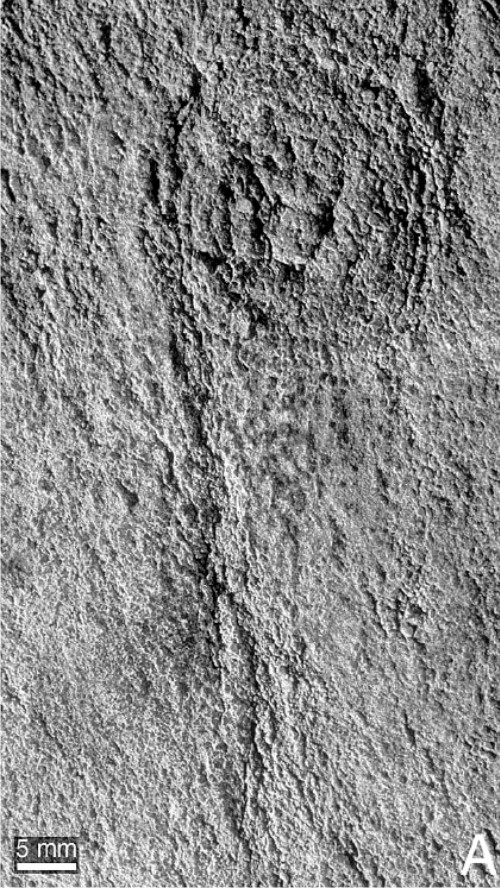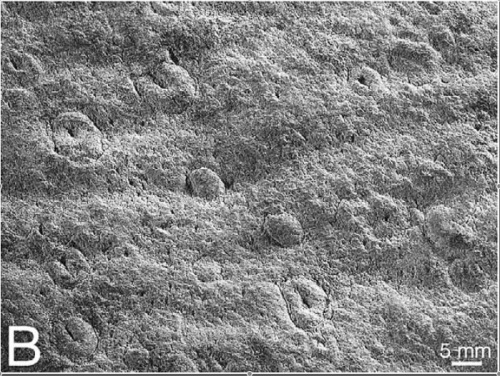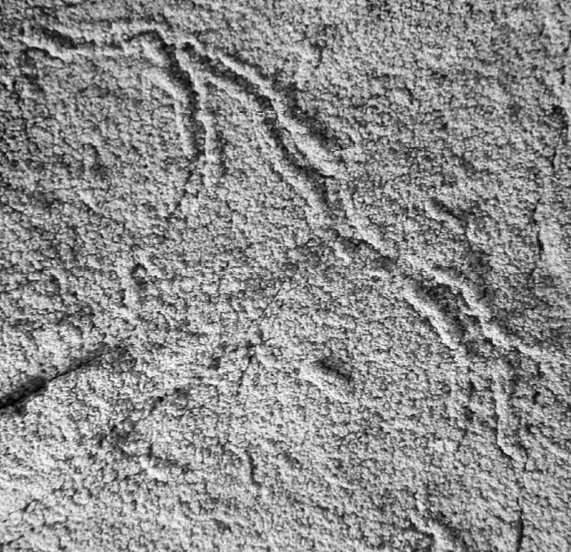I really wasn’t intending to leave Geopuzzle 14 hanging out unanswered on the interweb for as long as it has – and not just because my delay has apparently put my beer stash in jeopardy. The answer is actually both rather interesting, and rather controversial – because if this, and the other things that this was found with, are the imprints of large multicellular organisms, as their discovers claim, then we may have to significantly rewrite the history of life on Earth; for the rocks that they are found in are almost 2 billion years old.

The mystery blemish in this sandstone is not really a fossil in the technical sense of it being the mineralised remains of a once-living organsim. Instead, it is the preserved imprint of something that once rested on the sediment, which has somehow been preserved despite whatever made it decaying into nothingness – a fossilised absence, if you like. The imprint above seems to be that of a discoidal organism with some kind of stalk. In some horizons in the same formation, you find smaller discs with a central dimple:

These fossils are found in the Stirling Range Formation, part of a sequence found in southwestern Australia. As several of you astutely pointed out, in terms of both morphology and mode of preservation, they closely resemble Ediacaran fossils which have been found in several sequences dating back to the very latest Neoproterozoic, around 600 million years ago. Thus, after the initial discovery of these imprints in the 1990s, it was taken as an indication that the Stirling Range formation was also around this age, despite some earlier dating work that suggested this sequence was considerably older – at least 1.1 billion years, and perhaps more.
Directly dating sandstones is not straightforward, but you can establish upper and lower limits with careful study. A maximum age can be provided by dating detrital zircon grains which have been incorporated into the sandstone. These are eroded from pre-existing basement, so the sandstone was obviously deposited after the age of the youngest grain. A minimum age can be found by dating diagenetic or metamorphic minerals that formed during a tectonic, thermal or geochemical event at some point after the sandstone was laid down. Bengotson et al. (2007), the source of the above photos above, summarise how dating studies in the last decade have established a minimum age of 1.8 billion years, and a maximum age of 2 billion years, for the Stirling Range Formation. It’s a pretty broad range, but it is sufficient to definitively establish that these rocks record an age more than three times further back in time than the Ediacaran – but nonetheless, contain the traces of Ediacaran-like organisms.
One of the biggest questions about the history of life on our planet is: why did it take 2.5 billion years or more for the Earth’s inventory of life to contain anything other than single-celled organisms? If the Stirling fossils, and a couple of other claimed instances of Ediacaran-like fossils popping up in distinctly-older-than-Ediacaran rocks, are being interpreted correctly, then it’s possible that this is the wrong question, because it means one of two things: either they represent early but short-lived excursions into multicellularity – older ‘Cambrian explosions’ that fizzled, perhaps due to environmental conditions being marginal and unstable’; or, Ediacaran critters existed throughout most of the Proterozoic, and we have thus far only seen rare snapshots where quite special conditions allowed traces of these weird, soft-bodied things to be preserved.
Perhaps even more interesting is that according to Bengotson et al., they may have had company. They claim that the groove-like features in the picture below are real trace fossils, made by some actively mobile organism (the ‘trail’ is 2-3mm across).

This is an even more controversial claim, and as they concede in the paper, many dispute this interpretation. If this was the case though, this would possibly favour the idea that the Stirling fauna was a precocious, but ultimately limited and short-lived, experiment in multicellularity – the widespread survival of stromatolites until just before the beginning of the Cambrian would seem to argue against a long, poorly recorded history for actively grazing organisms. Still, these sorts of studies remind us that there remains much that we may not know about the early history of our planet.
Bengotson S. et al., Paleobiology, 33(3), 2007, pp. 351-381.



Comments (6)